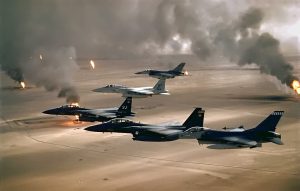
The controversy over the militarization of law enforcement has been a continuing question in the United States since the inception of the SWAT (Special Weapons And Tactics) concept of the late-1960’s. While some parties cover their own political biases on the subject by ranting about the US Federal Government providing “military equipment” to local law enforcement departments, primarily through Washington’s “LESO” program, such pandering to “fear-porn” is simply the willful refusal to acknowledge the reality that any “militaristic” expression of law enforcement is precisely what those hysterical parties demanded for years…and then were faced with results that they refused to believe were possible.
While rather clichéd, the popular idea of the “good police” was formed in the 1950’s by television shows such as Dragnet and the later Adam-12. As the years rolled by, however, it became increasingly apparent that the “good cop” – even if a real thing – was not capable of dealing with the new realities of criminal violence at the end of the 1960’s.
Increasingly, local police and county-level sheriff’s departments were faced with criminal gangs operating drug labs in remote rural areas, that offered criminals the ability to utilize military-style tactics to defeat police efforts at arrest. Similarly, worsening political violence in urban areas displayed a significantly different character than the violence of previous decades. In this context, armed groups – primarily Communist groups inspired by the likes of Vladimir Lenin, Mao Tse Deng, and Ernesto “Che” Guevara – attempted to initiate urban revolutionary warfare against the United States establishment and its citizens.
The passage of time, as well as the shifting motivations of the popular media, has downplayed the levels violence involved, to the point where the resurfacing of old training videos sponsored by state-level police departments are seen as almost fiction, when in fact, the reality was that violent attacks and kidnappings were frequent occurrences. What would now be openly called organized terrorist campaigns were waged by groups as diverse as the Weathermen, the Black Liberation Army, the Ku Klux Klan (KKK), and the Symbionese Liberation Army.
For these reasons, long-time observers were in no way surprised at the recent uptick in “ambush attacks” against police officers around the nation; indeed, the wonder was that the surge in such attacks had not happened earlier.
In response to the increasingly complex violence of the 1960’s, first the Philadelphia Police Department – quickly followed by the Los Angeles Police Department (LAPD) – established large teams of officer designated and trained to respond to various situation that were outside the realm of normal police duties. To a great degree, the SWAT concept was limited to dealing with bank robberies and hostage situations. This situation changed decisively after LAPD SWAT fought its landmark gun battle with the Symbionese Liberation Army on May 17, 1974. Police departments around the nation took note of a law enforcement unit being suddenly thrust into an openly military type of operation, and began to act accordingly.

Beginning with larger departments, SWAT-type units were formed within departments, and began training and equipping those teams accordingly, frequently seeking training advice from prior-military service veterans of the recently concluded Vietnam War, as those soldiers usually possessed skills not previously taught to police officers. The Federal Government took notice, with the FBI laying out the basis for its Hostage Rescue Team (HRT) in the late-1970’s, leading to its actual founding in 1983.
Civil police departments, however, quickly realized that they needed more extensive assistance to maximize a unit like a SWAT team. With the US military establishment being both legally restricted from directly aiding civilian law enforcement by the Posse Comitatus Act, and not wanting bad press in the aftermath of Vietnam, police departments struggled to properly equip their teams. However, as there was a concurrent decrease in strictly political violence as the 1970’s drew to a close, local departments used their SWAT units for both “high-risk warrant service” and hostage rescue situations. Both type of operations, of course, straddle the line between strictly police enforcement and military operations.

Beginning in 1990, with the National Defense Authorization Act for Fiscal Years 1990-1991, the Federal Government opened up the direct sale of military surplus equipment – including weapons and certain armored vehicles – to civilian law enforcement agencies, under what was then called the “1208 Program”, after where is appears in the enabling legislation. In 1996, various wording was changed and the law was expanded, going into effect in 1997, becoming the current “1033 Program”.
The vast bulk of the weapons and equipment available to civilian law enforcement agencies is gear that is either excess to the military’s needs, or is older equipment that the military has completely replaced in its Active, Reserve and National Guard units. Because of the heavily discounted amounts (down to “free for the taking”) offered to civilian law enforcement, this has been a great boon to expanding the capabilities of local police departments and their various special teams. Since 1997, though, while high-risk warrants and hostage rescues by police have certainly happened, but SWAT units in most departments are usually used to raid drug labs and dealers, which actions are specifically encouraged in the 1997 legislation.
Tactically speaking, these operations are far from military-level actions. The reasons are simple: such raids will have, at most, one to four hostiles that the police are planning on arresting, and even if the police teams meet resistance, it is certain to be short, disorganized and ineffectual. Most importantly, the criminals the SWAT teams are trying to arrest rarely have any desire to “fight it out to the bitter end”; actions like that certainly happen, but it is very rare. Criminals, by and large, are more likely to surrender than to fight to the death.
Two incidents, however, revealed the weakness of the widespread reliance on SWAT teams.
On February 28, 1997, serial bank robbers Larry Phillips Jr. and Emil Mătăsăreanu attempted to rob a Bank of America branch in the Los Angeles suburb of North Hollywood, sparking one of the largest gun battles in US police history. While the details – and video footage – of the shootout are widely available, the takeaway is that responding police officers were categorically incapable of dealing with a single pair of largely untrained criminals, operating under significant amounts of illegals drugs, who had no intention of surrendering. The pair of gunmen were finally taken down because their own incompetence, Phillips dying by his own hand, and an already-wounded Mătăsăreanu being mortally wounded by a hail of point-blank fire from three SWAT officers after a bungled attempt to flee.
Worse, however, were “after-action” interviews with the SWAT officers. While all of the responding police officers – and certainly the SWAT officers – displayed outstanding levels of bravery that should be justifiably recognized and hailed, their attempts at conveying accurate technical information was terrifyingly abysmal.
This is not a case of pedantic criticism. One of the chief tenants of military ability is being both “technically and tactically proficient”, in this case, being able to correctly identify both the types and capabilities of equipment, but also in making realistic assessments of hostile force’s capabilities. This was very definitely not in evidence in the aftermath of the shootout, even years later.
The other case was exposed serious issues in police response to determined, non-criminal violence was the 2008 terrorist attacks on the city of Mumbai, India. A 10-man team of terrorists from the Pakistan-based Lakshar-e-Taiba conducted a highly complex infiltration and attack operation against the city – a metropolis of over 12 million – lasting four days, with a frightening level of competence.
Local police were essentially helpless, as the attackers were not there to commit simple crimes like robbery or kidnapping. The terrorists were there to kill as many Indian civilians as they could; only one terrorist would ultimately survive to lay out the details of the operation for Indian police and military operators.
A 2013 Naval Postgraduate Study examined the question of potential United States civilian police response to a hypothetical Mumbai-style attack. The results are far from encouraging, especially given the events of the subsequent decade.
While very large police departments – such as the LAPD, among others – have written detailed plans for dealing with multiple “active shooter” incidents, and while acknowledging that improvised bombing attacks can generate larger number of casualties than infantry/commando style shooting attacks, both the study and those department’s own manuals also acknowledge that such dedicated types of attacks would generate widespread fear and terror (hence, the designation of “terrorist attack”) throughout not simply the urban area affected, but also throughout the wider region, as well as the nation as a whole.
Lurking under these stolid studies is a fundamental issue: Police officers – hysterical screaming to the contrary – are not mentally or psychologically prepared for a confrontation with a group such as Lakshar-e-Taiba. Taking down drug dealers, child traffickers and the occasional unstable individual are one thing; dueling with an organized, focused and dedicated team of shooters who are not operating for any of the conventional criminal reasons is an animal of an entirely different stripe.
As incidents from the North Hollywood shootout, to the Columbine and Uvalde school shootings demonstrate, many police departments around the country – regardless of the level of material support they may have received from the 1033 Program – are not psychologically prepared to deal with a single shooter who is willing to fight to the end, much less a pair of shooters, even when the shooters are completely untrained; the response of Nashville, Tennessee police officer to the recent school shooting there is the exception that demonstrates the rule.
In light of the foregoing, the continued hysterical demonization of American citizens to not simply defend themselves firearms in the absence of police, and equally strident calls to limit not only the ability of American citizens to own firearms, but to restrict their ability to obtain competent and useful training with weapons they already own, is highly worrying, given the demonstrated willingness of left-leaning city administrations to not only actively restrict their police departments from dealing with organized, large-scale violence, but also giving criminals literal “get out of jail free cards” for “petty crimes”.
This demonstrates, more than anything else, that the “average American citizen” is very much on their own when it comes to crime in their nearby areas.
If you are reading this inside the United States of 2024 – take note.








